It is a rare thing to find a breed of dog that is at once companionable, hard working, loyal and of lap-dog size as well, but the Shetland Sheepdog is all of these things. Although resembling the collie in miniature and originating from some of the same stock, the Sheltie was not bred down from the full-size Collie. The breed evolved from hardy ancestors which lived in the Shetland Islands off the coast of Scotland. Due to the harsh living conditions and close association with the people of the Shetlands, the Sheltie evolved into a miniature herding dog, small and sturdy, a true working dog with a "special something" still evident in his personality today.
Size: The ideal Sheltie, according to the Standard of the Breed, should stand between 13 and 16 inches at the shoulder. Because the Sheltie is still a young breed with many kinds of dogs in its background, size is still one of the most tenacious problems plaguing the breeder today, with both oversize and undersize Shelties appearing, sometimes in the same litter.
Personality: The Sheltie may be reserved toward strangers, but not shy. He is generally a very happy and lively dog, willing to please his owner. He is affectionate and loyal, and easily adaptable to his owner's moods. He excels in obedience and in agility. His intelligence level ranks among the most highly developed of all canine breeds.
Male or female: Male Shelties are apt to carry more coat than females, therefore requiring a bit more grooming. Females should be more feminine, with a closer, more fitted coat. Both sexes are much the same in both disposition and character, and both make equally good pets.
 |
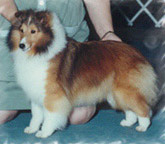 |
|
|
|
Coat: Shelties have a double coat, the outer layer consisting of long,straight, harsh hair, and the undercoat short, furry and very dense. The mane should be abundant, and more impressive in the males.
Colors: Sheltie coats can be Sable (ranging from golden to mahogany), Blue Merle, Tri-Color, Bi-Black or Bi-Blue. They can be marked with varying amounts of white and/or tan.
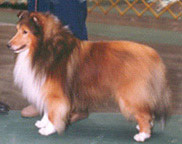 Sable - Golden |
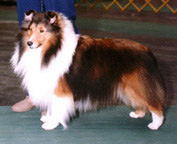 Sable-Mahogany |
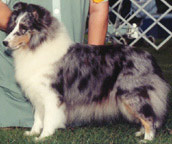 Blue Merle With Tan |
Tri |
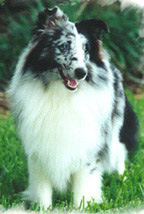 Bi Blue |
Bi Black |
Grooming: How much grooming your Sheltie will need depends on the individual dog. The Sheltie is a very clean dog, and with a minimum of effort can be kept beautiful and comfortable. On the average, a daily once-over, combined with a weekly vigorous brushing, is all that's required. Shelties also require periodic nail trimming, ear care, and teeth cleaning to prevent early tooth loss or gum disease. Male Shelties normally shed their undercoat about once a year, while females usually she twice a year, shortly after their "heat" cycles.
Exercise: Your Sheltie will adapt himself to your way of life. If you lead a quiet life-style, with no exercise, so will he, but it will not be healthy for him. If you have a fenced-in yard, where he can run around, fine. If not, long walks, or throwing a ball in the park, will keep both you and your Sheltie in shape. Shelties will do well in any environment as long as the necessity for regular exercise is understood.
Socialization: This is the way you teach your Sheltie puppy how the world works. This is done by going on "field trips" to the park, playground, shopping center, a friend's home or gatherings where your puppy is welcome. A puppy that is not given this frequent away-from home experience between 12 and 20 weeks of age may not develop that outgoing, friendly Sheltie temperament.
Training: Shelties are extremely intelligent, and quick to learn. They are happiest when they are participating members of the family. Shelties are ready for beginning obedience classes at four to six months of age.
Availability: If you decide a Shetland Sheepdog is indeed the dog for you, the best way to go about finding one is to contact an established breed club or, if you have a chance, to visit a dog show and talk to the exhibitors after the show.
Hip Dysplasia: Before buying a puppy, ask if the parents have been x-rayed for hip dysplasia. This hereditary condition is present in most breeds of dogs. An orthopedic Foundation for Animals (OFA) number is given to dogs free of this disabling condition. The OFA clearance is not a guarantee that your puppy will not develop dysplasia, but breeding only x-rayed cleared stock limits the possibility of developing the problem.
(Text modified for use on this site via the Shetland Sheepdog Club of Northern CA)
